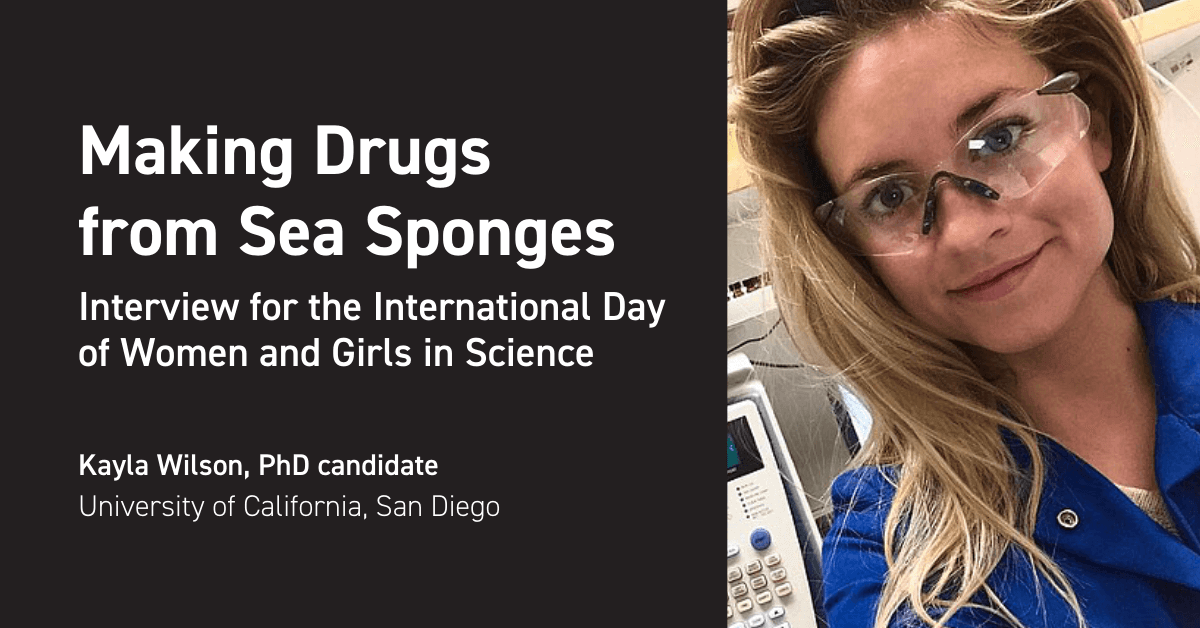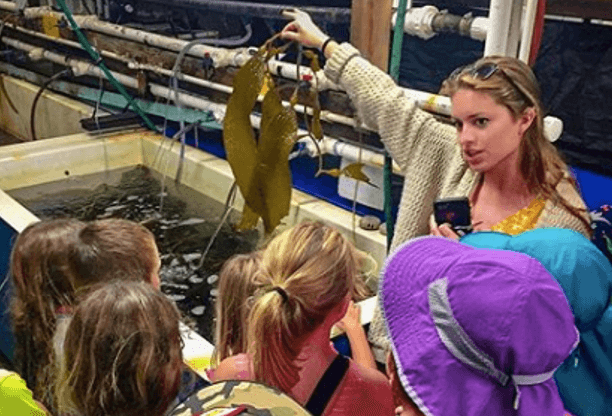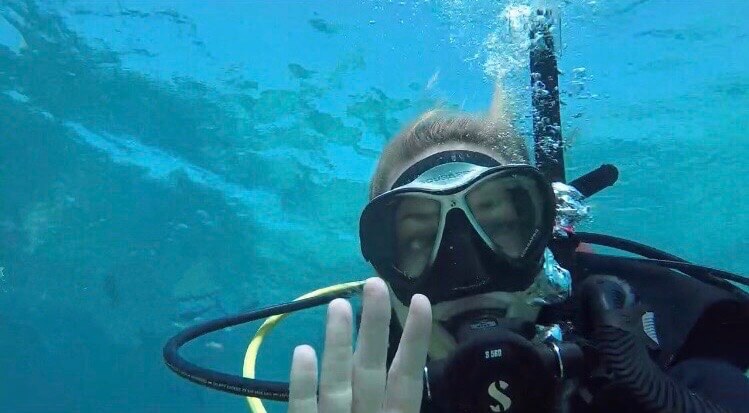Making Drugs from Sea Sponges - An Interview for the International Day of Women and Girls in Science

“To rise to the challenges of the 21st century, we need to harness our full potential. That requires dismantling gender stereotypes. On this International Day of Women and Girls in Science, let’s pledge to end the gender imbalance in science.”
According to the UNESCO Institute for Statistics, less than 30% of the world’s researchers are women. The proportion of female Nobel laureates recognized in a scientific category: 3% (20). To raise global awareness for this inequity, the United Nations General Assembly observes February 11th as the International Day of Women and Girls in Science.
In a recent interview, Dr. Jennifer Stimpson (2020’s Albert Einstein Distinguished Educator Fellow currently serving as a U.S. Congressional Fellow in Washington, DC) shared some thoughts about the importance of visible role models for girls, especially in STEM fields: “If you have a role model in that space, a girl will change her trajectory and say, ‘I wanna be like her’...And so...I do everything that I can to make sure that all girls see that it’s possible, and recognize that they can do it as well.
In the words of the UN, February 11th is a day for “celebrating women and girls who are leading innovation and calls for action to remove all barriers that hold them back.” Today on Writing the Future, we shine a spotlight on Kayla Wilson, a Ph.D. candidate at Scripps Institution of Oceanography (a department of UC San Diego). She is a former student of Dr. Stimpson’s, a Twist customer, and a science educator on TikTok. We interviewed Kayla to learn more about her research, the journey that brought her to her scientific focus, and the role models that inspired her along the way.
At Twist, we take pride in knowing that Diversity is in our DNA, and believe that ensuring broader cultural, ethnic, and gender representation in the sciences is essential to advancing scientific discovery, and ultimately the betterment of humanity globally. We hope to take a page from Dr. Stimpson’s playbook and share the story of someone we think is a great role model for girls—and maybe, just maybe, can help change someone else’s trajectory.
Kayla. You’re a Ph.D. candidate at Scripps; can you give me a quick overview of how you ended up there?
Sure. I grew up in Texas, did my undergrad in Tennessee (and at sea), and now I’m in San Diego with my dog, working on my Ph.D. in Marine Biology. I’m focused on understanding the biosynthesis of bioactive molecules that we find in marine organisms. I sequence their DNA to find out what biosynthetic genes and enzymes are responsible for making cool molecules that might become therapeutic drugs.
When did you know you wanted to be in science, or was there a pivotal moment that made you know, “yes, marine biology is it”?
I was surrounded by mentors throughout my younger years, but it was choosing to sail across the Atlantic Ocean that was the pivotal moment for me.
After a terrible breakup and a shift in direction away from Medicinal Chemistry shook up my world, I decided to participate in a program called SEA Semester (Sea Education Association). Through that program, I realized there was so much more to the ocean than I ever knew, and found out you can do drug discovery from marine organisms. It was the perfect intersection of my experience with medicinal chemistry and the ocean. That’s how I ended up at Scripps, which is one of the only places in the U.S. that has a full program for marine biotech and marine biomedicine.

You mentioned that mentorship in your younger years was largely responsible for your choice to pursue science. What else was a contributing factor?
It was really about my educational environment. At an all-girls high school, I didn’t have to worry about being talked over or intimidated by males when speaking up in class, because there were only women in my science classes, answering the questions and sharing their opinions; we were all accustomed to speaking up and participating without that negative dimension.
My Chemistry teacher in sophomore year, Jennifer Stimpson, was amazing. She was named an Einstein Fellow last year and will be working on education policy in D.C. this year. I was also set up in a microbiology research experience program as a high school senior by Dr. Barbara Fishel. That early exposure fully turned me on to what research is really about. It showed me how creative and human it is. Then in college, I met up with Dr. Larryn Peterson, and did research in her lab throughout my education there. So a lot of really great educators had a large impact on my decision to pursue this path.
So what is your research question? What’s your thesis about?
I study sea sponges because they make a lot of really interesting chemicals. The first antiviral drug that was ever approved in the United States, which is called Acyclovir, was very heavily based on a molecule that was discovered in a sea sponge, and a lot of other antiviral drugs that we still use today are based on this scaffolding that was originally discovered in a sponge.
We’ve known for some time that sea sponges create really interesting molecules. More recently, now that we have the ability to deep sequence these organisms, we have learned that they play host to really complex microbial communities.
They have a microbiome just like we do, and we found that the vast majority of the chemistry in sea sponges is produced from their microbes. The lab I work in focuses on looking at the genomes of these organisms, and figuring out which genes encode the enzymes that make these interesting molecules.
My work really focuses on a particular sea sponge that’s local to San Diego. I go SCUBA diving, collect my sponge, take it back to my lab, process and analyze it, sequence the DNA and RNA, and search for the genes that make interesting molecules.
SCUBA diving as a required component of preparing your thesis? Rough life!
I know, right? When I was thinking about which program to do, it did occur to me that this one is the only one that’s going to pay me to SCUBA dive. Not gonna lie, that definitely factored into my decision.

How did you settle on sea sponges? As a diver, you had a myriad of fascinating underwater organisms to choose from.
Lots of reasons! First of all, when it comes to drug discovery related to ocean life, you really have to look at marine invertebrates and microbes, especially marine invertebrates that are sessile (can’t move). If you are not able to move, and are stuck to a rock or the bottom of the ocean, you still need to defend yourself. Without teeth to bite, or claws to fight, or fins or legs to escape with, you have to rely on chemical warfare.
There are a variety of organisms we’ve found that have interesting toxins—and often something that’s a toxin can be a medicine in a smaller dose. Some marine organisms that have led to drugs are: marine bacteria, sponges, tunicates or sea squirts, some corals, cone snails. If we go back into the fossil record and also do some evolutionary analysis, we think that sea sponges and cone jellies are the first animals to evolve on Earth; they predate the Cambrian explosion by hundreds of millions of years. So they’ve had a head start in making these compounds, and tend to be pretty good at it.
I knew when I went into this program that I wanted to do drug discovery from the ocean, and it became pretty clear that sponges are just really good at making marine natural products. I knew I wanted to focus on local life, so I went diving, collected a bunch of different sponges, studied them to find out if they’re making cool molecules, and found that some of them were, and so...that’s how I settled on my sponges.
Can you share anything more about what you’re trying to discover? What’s “The Question” you want to answer?
I work on Isoprenoids - a really large class of molecules that include cholesterol, steroids, a lot of the chemicals that are in essential oils that make plants and flowers smell good (volatile terpenoids). I’m working with a fairly unique molecule within that class.
I’m also trying to understand how they’re made. We know they’re made by sponges, but we haven’t been able to go back into the DNA sequence of these sponges and their microbes and figure out how they are synthesized. So my goal is to find out which genes in which organisms are responsible for making these molecules.
Have you ever changed “The Question?” Any moments when you thought, “Nope, this isn’t it.”
Oh jeez. Yes and no. I mean, the big question has remained the same. But the questions within The Question? There have been plenty of times where I just thought, “This is so dumb. I’ve tried everything. I’ve tried this a million times, it’s not working, I hate it, I don’t want to think about it.” Yeah. There are a lot of emotions in research that I think we don’t talk about enough.
How do you cope with those frustrations and disappointments?
I think a lot of it is connections with other people. And that’s a lot of why I’m in science. I like collaborating with other people, and talking to other people about science, picking their brains. When I’m in those low moments, I force myself to meet with my advisor, or my mentor, or other people in my lab just to vent or bounce ideas off of them. Even that can be helpful.
I’ve always prioritized finding good people to work with over finding people with prestige. I have no problem saying “I’m not going to work with you” if people are toxic or disrespectful. I will never compromise my mental well-being or sense of my own value, for a high impact journal paper. Prestige isn’t the right priority.
Yeah. So what about any high moments in your research?
During COVID, through bioinformatic manipulation of DNA sequencing data, I was able to find these jewels of enzymes that I totally overlooked because they’re so weird. Computationally, they look sort of like the other enzymes I’ve been studying, and the analysis programs I was using just weren’t picking them up. So I found new enzymes and got that jolt of “oh my gosh, these are new and interesting!” Every step of the way, it’s gotten better and better. I have just sent them to Twist to synthesize. The new data makes me think this might be the enzyme I’ve been looking for, that’s been a real high moment, that eventual discovery that gets you thinking “Oh! MAYBE THIS IS THE THING.”
So how do you see your work contributing to humanity or our general Earth ecosystem?
We can use enzymes to do so many interesting things. Like making cheese. Half of the cheese in the world was produced using synthetic enzymes. Most laundry detergents have enzymes that help to break down stains and help get oils out of your clothes. Then there are enzymes that have been approved as treatments for diseases; people who are missing enzymes in their own bodies can use enzymes that we synthesized in the lab to treat those diseases.
I also think the work I do helps positively impact the way that we make drugs and interesting molecules. There are lots of reasons to use enzymes over chemicals when making any sort of molecule. Enzymes are a lot more environmentally friendly; they don’t require super harsh reaction conditions. Another benefit is that they’re so much better at chemistry than we are. Enzymes have had billions of years of evolution to figure out how to make a molecule in the most efficient and safest and easiest way possible. Enzymes are great and we should be using them to make more things.
If I can find new, interesting enzymes in sea sponges that can be used to make medicinal compounds, therapeutic drugs, I’m all for that. That’s what I want to do.
More information on the background and importance of the International Day of Women and Girls in Science is available on the United Nations website here.
What did you think?
Like
Dislike
Love
Surprised
Interesting